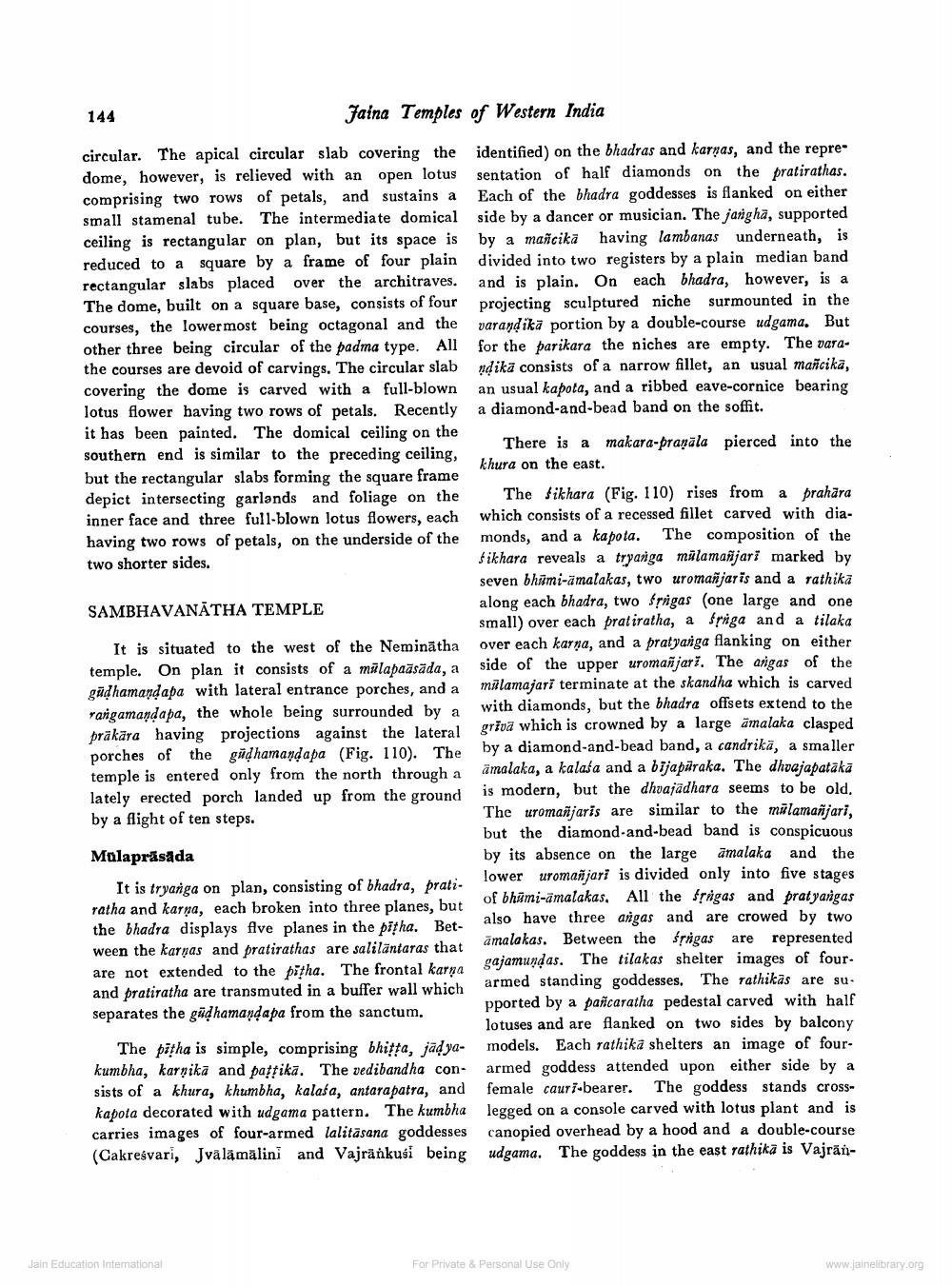________________
144
Jaina Temples of Western India
circular. The apical circular slab covering the identified) on the bhadras and karņas, and the repredome, however, is relieved with an open lotus sentation of half diamonds on the pratirathas. comprising two rows of petals, and sustains a Each of the bhadra goddesses is flanked on either small stamenal tube. The intermediate domical side by a dancer or musician. The jarigha, supported ceiling is rectangular on plan, but its space is by a mañcika having lambanas underneath, is reduced to a square by a frame of four plain divided into two registers by a plain median band rectangular slabs placed over the architraves. and is plain. On each bhadra, however, is a The dome, built on a square base, consists of four projecting sculptured niche surmounted in the courses, the lower most being octagonal and the varandika portion by a double-course udgama. But other three being circular of the padma type. All for the parikara the niches are empty. The varathe courses are devoid of carvings. The circular slab ndika consists of a narrow fillet, an usual mañcika, covering the dome is carved with a full-blown an usual kapota, and a ribbed eave-cornice bearing lotus flower having two rows of petals. Recently a diamond-and-bead band on the soffit. it has been painted. The domical ceiling on the southern end is similar to the preceding ceiling,
There is a makara-pranāla pierced into the
khura on the east. but the rectangular slabs forming the square frame depict intersecting garlands and foliage on the The Sikhara (Fig. 110) rises from a brahāra inner face and three full-blown lotus flowers, each which consists of a recessed fillet carved with diahaving two rows of petals, on the underside of the monds, and a kapota. The composition of the two shorter sides.
$ ikhara reveals a tryaniga malamañjari marked by
seven bhâmi-āmalakas, two uromañjaris and a rathika SAMBHAVANATHA TEMPLE
along each bhadra, two śrrigas (one large and one
small) over each pratiratha, a friga and a tilaka It is situated to the west of the Neminātha over each karna, and a pratyanga flanking on either temple. On plan it consists of a malapaāsāda, a side of the upper uromanjari. The argas of the gūdhamandapa with lateral entrance porches, and a milamajari terminate at the skandha which is carved Tangamandapa, the whole being surrounded by a with diamonds, but the bhadra offsets extend to the präkära having projections against the lateral griva which is crowned by a large ämalaka clasped porches of the gūdhamandapa (Fig. 110). The by a diamond-and-bead band, a candrikā, a smaller temple is entered only from the north through a amalaka, a kalaša and a bija piraka. The dhvajabataka lately erected porch landed up from the ground
is modern, but the dhvajadhara seems to be old. by a flight of ten steps.
The uromasjaris are similar to the malamasjari,
but the diamond-and-bead band is conspicuous Malaprāsada
by its absence on the large amalaka and the It is tryanga on plan, consisting of bhadra, prati.
lower uromañjari is divided only into five stages ratha and karna, each broken into three planes, but
of bhümi-amalakas. All the frågas and pratyavigas the bhadra displays five planes in the pitha. Bet
also have three angas and are crowed by two ween the karşas and pratirathas are saliläntaras that
amalakas. Between the sprigas are represented
gajamuşdas.
The frontal karya are not extended to the pitha.
The tilakas shelter images of fourand pratiratha are transmuted in a buffer wall which
armed standing goddesses. The rathikas are su. separates the gūdhamandapa from the sanctum.
pported by a pañcaratha pedestal carved with half
lotuses and are flanked on two sides by balcony The pitha is simple, comprising bhitta, jadya- models. Each rathika shelters an image of fourkumbha, karnikā and pattika. The vedibandha con armed goddess attended upon either side by a sists of a khura, khumbha, kalaša, antarapatra, and female cauri-bearer. The goddess stands crosskapota decorated with udgama pattern. The kumbha legged on a console carved with lotus plant and is carries images of four-armed lalitasana goddesses canopied overhead by a hood and a double-course (Cakreśvari, Jvālāmālini and Vajrāňkusi being udgama. The goddess in the east rathika is Vajrāv
Jain Education International
For Private & Personal Use Only
www.jainelibrary.org




